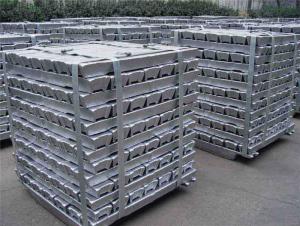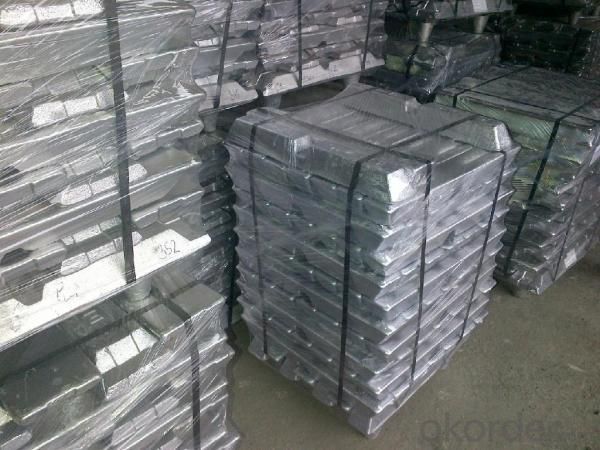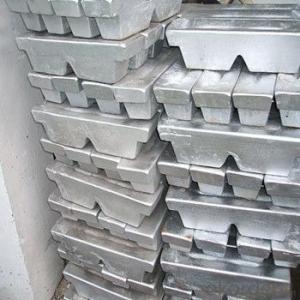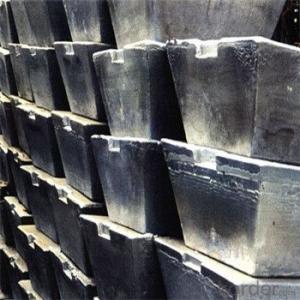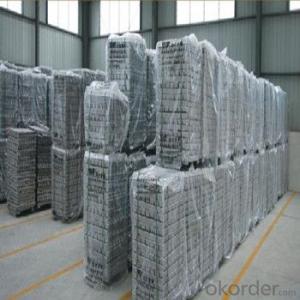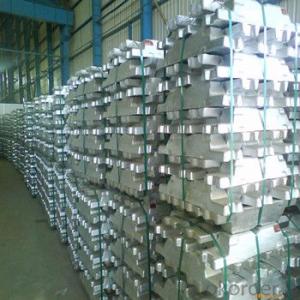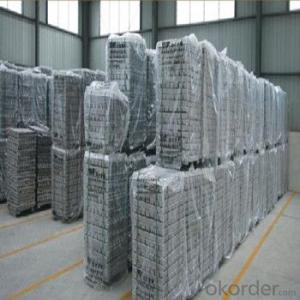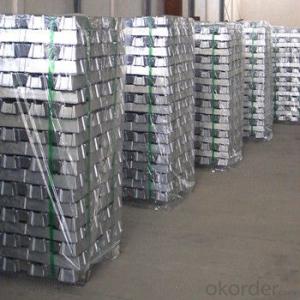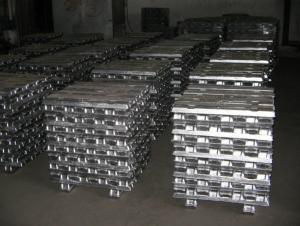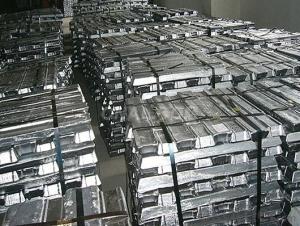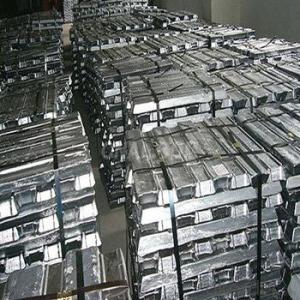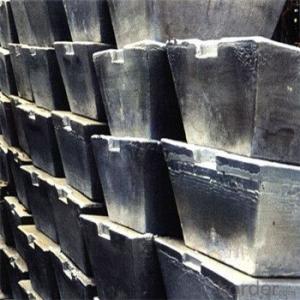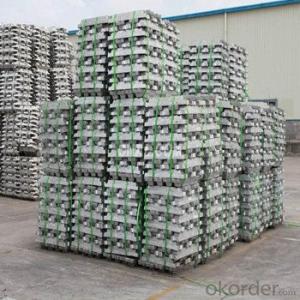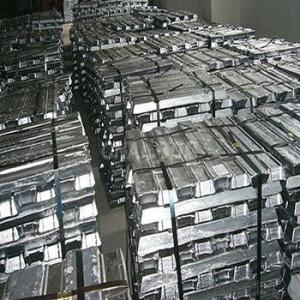Aluminum Ingots AA1070
- Loading Port:
- Shanghai
- Payment Terms:
- TT or LC
- Min Order Qty:
- 20 Tons m.t.
- Supply Capability:
- 1000 Sets Per Month m.t./month
OKorder Service Pledge
OKorder Financial Service
You Might Also Like
1. Specifications of Aluminum Ingots AA1070
Product Name | Aluminum Ingot |
Chemical Composition | Al |
Weight | 20/25kg |
Al (Min) | 99%-99.9% |
Appearance | silvery white |
Advantages | easy control and operation, fast melting |
Chemical Composition of Aluminum Ingots AA1070:
Grade | Chemical Composition % | |||||||||
Al≥ | impurities ≤ | |||||||||
Si | Fe | Cu | Ga | Mg | Zn | Mn | others | Sum | ||
Al99.9 | 99.90 | 0.50 | 0.07 | 0.005 | 0.02 | 0.01 | 0.025 | - | 0.010 | 0.10 |
Al99.85 | 99.85 | 0.80 | 0.12 | 0.005 | 0.03 | 0.02 | 0.030 | - | 0.015 | 0.15 |
Al99.7 | 99.70 | 0.10 | 0.20 | 0.010 | 0.03 | 0.02 | 0.030 | - | 0.030 | 0.30 |
Al99.6 | 99.60 | 0.16 | 0.25 | 0.010 | 0.03 | 0.03 | 0.030 | - | 0.030 | 0.40 |
Al99.5 | 99.50 | 0.22 | 0.30 | 0.020 | 0.03 | 0.05 | 0.050 | - | 0.030 | 0.50 |
Al99.00 | 99.00 | 0.42 | 0.50 | 0.020 | 0.03 | 0.05 | 0.050 | - | 0.050 | 1.00 |

2. Usage/Application of Aluminum Ingots AA1070
1. mainly used for melting ingot
2. discontinuous melting with scrap
3. easy control and operation
4. fast melting
5. Used for industry such as automobile,pinning and weaving,electron broadly and so on
3.Packaging & Delivery of Aluminum Ingots AA1070
About 25Kg /Ingot, Packed in wooden case, Net weight 1000Kg/ Case, or as customer's requirements.
(1)Standard seaworthy export packing, wooden pallets with plastics protection for the coil and sheet. (2)15-20MT can be loaded into 20 foot container, we try to use 20 foot container, and the sea freight rate is much cheaper than 40 foot container. (3) The other packing can be made based on the customer requirement. (4) The packing is very strong, which has 3 lays, thick fiber, and foam, plastic. The bottom is wooden pallets
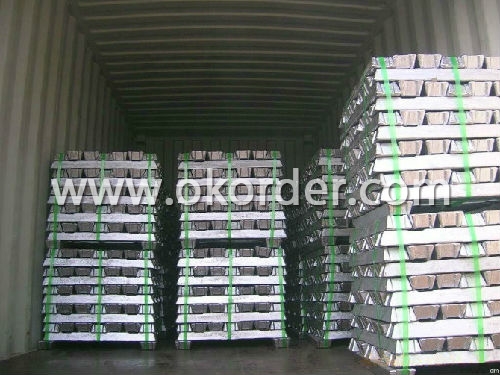
- Q: What is the tensile strength of aluminum ingots?
- The tensile strength of aluminum ingots can vary depending on the specific alloy and manufacturing process used, but on average, it ranges between 20,000 and 60,000 pounds per square inch (psi).
- Q: How much capital do I need to invest in the recycled aluminium ingot?
- This mainly depends on how much money you scale, there are local to not to do this, I am here in Foshan now, we're not here to make this move to distant places to engage in equipment, don't need how much, I have many friends in this, but now we're not here to do
- Q: Our unit is aluminum smelting enterprise, mainly producing aluminum ingots. The unit adopts wet dedusting equipment, and the packing tower explodes!
- Aluminum chemical nature is lively, is a kind of metal dust explosion, explosion limit concentration of 30g/m3 1.24Mpa, the maximum explosion pressure, the maximum pressure rise rate of 41.5Mpa/s, the explosion index 41.5Mpa.m/s, risk rating St1.
- Q: Want to do a scrap processing of aluminum ingots of small workshops, about investment of about 100 thousand, the specific process, need what equipment technology, please expert advice
- Because it is profit, a ton of scrap, more of a water, is 160 dollars. The equipment is also very critical, when bad equipment in the melting scrap loss is large, so the water rate is down. Experienced and inexperienced, the difference in the rate of effluent can be 10 points. It is suggested that on-the-spot investigation should be conducted with prudent investment.
- Q: What are the different casting methods used for aluminum ingots?
- There are various casting methods commonly utilized in the production of aluminum ingots. These methods encompass: 1. Utilizing Permanent Mold Casting: This technique involves the use of an iron or steel permanent mold to shape the molten aluminum into ingots. The mold is preheated and coated with a release agent to prevent sticking. The molten metal is then poured into the mold, left to solidify, and subsequently, the mold is opened to extract the ingot. 2. Employing Continuous Casting: This method necessitates pouring the molten aluminum into a water-cooled mold that possesses a continuous cavity. As the metal solidifies, it is constantly drawn out of the mold, resulting in a continuous strand of aluminum ingots. This approach is frequently employed for the production of substantial quantities of ingots with consistent shapes. 3. Implementing Sand Casting: Sand casting is a widely employed technique for casting aluminum ingots. A sand pattern of the desired ingot shape is created, and then the mold is formed by packing sand around the pattern. The molten aluminum is poured into the mold and allowed to cool and solidify. Once solid, the sand mold is broken apart to reveal the ingot. 4. Utilizing Die Casting: Die casting is a method commonly used to produce small to medium-sized aluminum ingots with intricate details. In this process, a steel mold, known as a die, is employed. The molten aluminum is forced into the die at high pressure and rapidly cooled to solidify. The die is then opened, and the ingot is ejected. 5. Employing Centrifugal Casting: In this method, the molten aluminum is poured into a rotating mold. The centrifugal force causes the metal to spread out and solidify against the mold walls, resulting in a cylindrical ingot. This approach is particularly beneficial for manufacturing hollow or tubular ingots. Each casting method possesses its own set of advantages and disadvantages, and the selection of the method depends on factors such as the desired ingot shape, size, quantity, and specific application requirements.
- Q: What are the different extrusion processes for aluminum ingots?
- Aluminum ingots can undergo various extrusion processes, each with distinct characteristics and applications. Some commonly employed methods for aluminum extrusion are: 1. The most widely used process for aluminum ingots is direct extrusion. It involves heating the ingot and pushing it through a die using a ram or hydraulic press. The material flows in the same direction as the ram, resulting in a continuous profile with a consistent cross-section. 2. Indirect extrusion, on the other hand, utilizes a stationary die and a hollow ram to force the ingot through the die. The material flows in the opposite direction of the ram, resulting in a profile with superior surface finish and improved mechanical properties. 3. Impact extrusion is employed to create hollow shapes like tubes or containers. It entails striking a punch against the ingot, causing the metal to flow around the punch and form the desired shape. Impact extrusion is ideal for high-volume production of small parts. 4. Unlike the aforementioned processes that involve heating, cold extrusion is conducted at room temperature. The ingot is placed in a die and compressed using a hydraulic press or mechanical force. Cold extrusion is particularly useful for producing intricate shapes with precise tolerances and excellent surface finish. 5. Hydrostatic extrusion necessitates placing the ingot in a sealed chamber filled with a liquid, typically oil or water. Pressure is exerted on the liquid, which then applies even pressure on the ingot. This method is often employed for extruding alloys with low ductility or complex shapes. Each extrusion process presents its own advantages and limitations, and the choice depends on factors such as the desired product shape, material properties, production volume, and cost considerations.
- Q: 102 non-standard aluminum ingot is like? And ordinary non-standard aluminum ingot what is the difference?
- Nonstandard 102 is aluminium ingot produced by waste aluminium smelting, containing silicon between 8-12%, and remaining iron, zinc and copper content below 1Lower quality requirements for die casting aluminium ingots
- Q: How can I make aluminium ingots for cans?
- You need a basic open hearth is heating aluminum cans, but is not the direct melting aluminum ingot what meaning, that thing in a lot of impurities, but also remove the magnesium, zinc, manganese and other elements, these processes need professional personnel, so difficult to master.
- Q: What are the impurities found in aluminum ingots?
- Aluminum ingots, which are the primary raw material for various aluminum products, can contain several impurities. These impurities can be broadly classified into metallic, non-metallic, and gas impurities. Metallic impurities found in aluminum ingots include elements such as iron, silicon, copper, manganese, zinc, and magnesium. These impurities can originate from the raw materials used in the production process or from the equipment used during the melting and casting of the ingots. Metallic impurities can negatively impact the quality and performance of the final aluminum products, affecting their strength, corrosion resistance, and other mechanical properties. Non-metallic impurities in aluminum ingots consist of various compounds and particles, such as oxides, carbides, nitrides, and sulfides. These impurities can arise from the presence of oxygen, nitrogen, sulfur, or carbon in the production process. Non-metallic impurities can cause defects in the aluminum products, such as porosity, inclusions, or uneven microstructure, which can weaken the material and reduce its overall quality. Gas impurities are another type of impurity found in aluminum ingots. Common gases that can be present in the ingots include hydrogen, oxygen, nitrogen, and carbon monoxide. These gases can be introduced during the melting and casting process or can result from the interaction of the molten aluminum with the surrounding atmosphere. Gas impurities can lead to internal defects in the aluminum products, such as gas porosity or bubbles, which can impair their mechanical properties and appearance. To ensure the quality of aluminum ingots and the resulting aluminum products, rigorous quality control measures are employed throughout the production process. Various techniques, such as refining, degassing, and filtration, are employed to minimize the presence of impurities in the ingots. Additionally, thorough testing and analysis are performed to monitor and verify the impurity levels in the ingots, ensuring compliance with industry standards and customer requirements.
- Q: How can I extract aluminium ingots from cans?
- The most basic is that you need an open hearth, is heating aluminum cans, but direct melt is not what the meaning of aluminum ingot
1. Manufacturer Overview
| Location | Henan,China |
| Year Established | 1993 |
| Annual Output Value | Above US$200 Million |
| Main Markets | Mid East;Eastern Europe;North America |
| Company Certifications | ISO 9001:2000;ISO 14001:2004;OHSAS 18001 |
2. Manufacturer Certificates
| a) Certification Name | |
| Range | |
| Reference | |
| Validity Period |
3. Manufacturer Capability
| a) Trade Capacity | |
| Nearest Port | Shanghai |
| Export Percentage | 30%-50% |
| No.of Employees in Trade Department | 21-50 People |
| Language Spoken: | English;Chinese |
| b) Factory Information | |
| Factory Size: | Above 100,000 square meters |
| No. of Production Lines | Above 10 |
| Contract Manufacturing | OEM Service Offered;Design Service Offered |
| Product Price Range | Average |
Send your message to us
Aluminum Ingots AA1070
- Loading Port:
- Shanghai
- Payment Terms:
- TT or LC
- Min Order Qty:
- 20 Tons m.t.
- Supply Capability:
- 1000 Sets Per Month m.t./month
OKorder Service Pledge
OKorder Financial Service
Similar products
Hot products
Hot Searches
Related keywords

